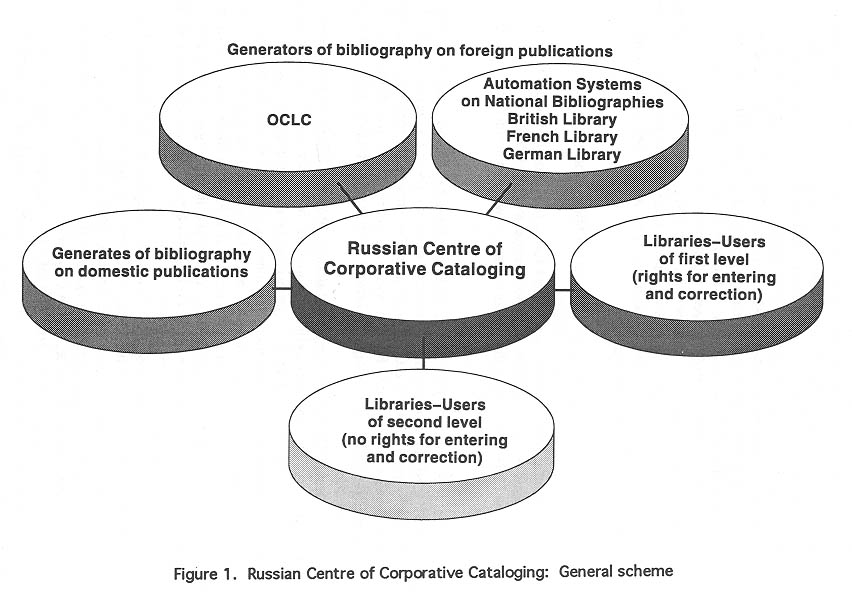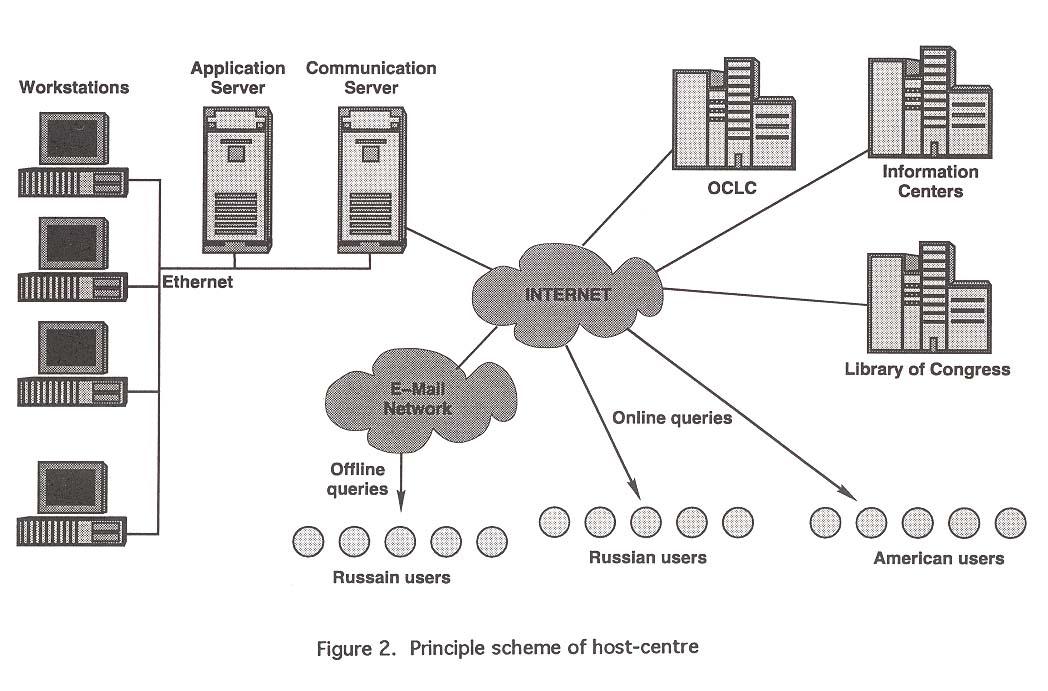

Yakov L. Shraiberg
Rusian National Public Library for Science and Technology
Moscow, Russian
e-mail: shra@gpntb.msk.su
One of the benefits of global information infrastructure (GII) development is free information exchange and availability of information. Unfortunately the information exchange between Russia (the former USSR) and Western coun-tries was hindered, and the access to Russian information was limited. It was due not so much to the notorious Russian "closeness" and secrecy, but largely to the three main factors:
• the content of information were oriented towards inner application, i.e., abstracts were scarce in total volume of information flows, factographic data were even less common, and only with rare excep-tions, no attempts were made to supplement, emphasize separate segments, to make information a commodity (intended not for sale first of all), but in the sense of merchantability of the kind (the contents).
• as to the means of access and transfer of results, the country was at an initial stage, since even affordable average-quality communi-cation means were unavailable.
Since the early 1990s the information barrier has been gradually removed and intensive cooperation has started between Russian and foreign libraries and information centers. Although some types of cooperation did exist long before, first of all interlibrary loans (ILL) and then the International Book Exchange, yet they operated as separate though sometimes well-developed functions. Now Russian libraries have begun to quit the artificial formats of the years of confrontation like State Communication Format (GKF) and International Ex-change Format accepted in the countries of the socialist camp (MEKOF), and have begun to adapt the family of MARC-formats, in particular UNIMARC. UNIMARC has become increasingly popular as a communication exchange for-mat. Inner system formats of many automated information and library sys-tems have become closer to USMARC. Bilingual (Russian and English) data-bases occupy increasingly more space, abstracting and indexing are treated more seriously, and finally, local telecommunication networks and network providers have appeared with the Internet electronic mail operates at full capacity. Very soon Internet-online became available to libraries.
All these steps have allowed Russian libraries to start making their own contribution to the global information network and infrastructure, though many problems still remain to be solved.
Despite the fact that a group of Russian libraries is already working in the online mode, there is no real library network yet. A LIBNET project was developed to link 5 major Moscow libraries via low speed noisy public tele-phone channels. A project entitled "Russian Libraries in the Internet" has been elaborated. In perspective, it will provide a possibility for linking 16 Russian libraries to the Internet fiber-optic channels. There is a number of other projects. However, there is still no computer library network. For example, there are practically no shared systems of library integration. The only exception is the system of Union Catalog of sci-tech literature, acquired by Russian libraries. The system, maintained by the Russian National Public Library for Science and Technology since 1987 in the automated mode, has a databank containing over 700,000 bibliographic records including retrospec-tive and operating in the online mode. It has some 400 corporate participants (in 1990 the number of participants was 2,500), but nevertheless it supports the sci-tech part of the main flow of publications. It does not ensure the functions of centralized (and shared) cataloging.
Thus, it is possible to present the existing alignment of forces in the Russian library-information space with the following before the country's envisioned advance into the GII:
2. The telecommunication and network infrastructure, being the essen-tial condition for entering the GII, is underdeveloped. Though in comparison with the previous years, many commercial networks and service-providers have appeared in the country, as a rule libraries and information institutes cannot afford them because of their prices. Libraries' great hopes are to connect to the Internet via noncommercial hosts. Although a number of libraries has already been connected, this access still remains unavailable to a majority of libraries. The realization of a number of projects is to allow to resolve the problem of access to the global information resources via the Internet.
3. The state of automation and the resolved problem of connection to the Internet do not solve the problem in ensuring the Russian libraries to be a part of GII in the field of bibliographic information. National bibliography is one of the largest and representative infor-mation arrays. If it is accessible and is used within the country effectively, and if it is accessible for external users, including foreign users, then we have made a serious step forward on the way to establishing our own information system as a part of a global system in entering the GII.
We must emphasize that the problems of centralized (shared) cata-loging and access are of paramount importance to Russian libraries from the perspective of their own information infrastructure development and further movement to the GII.
3. PROBLEM SOLVING
The main organizational and technological aspects of solving the above men-tioned problems are:
• Reducing the cataloging costs, which under autonomous technolo-gies are rather considerable and show steady tendencies of growth.
• improvement of the forms and methods of library service, as well as the scope and quality of library services;
• overall development of libraries and librarianship.
One of the impressive examples of this realization is the experience of Online Computer Library Center (OCLC). The OCLC embraces some 20,000 libraries of the USA and its 60 user countries. The OCLC center and a part of over 3,000 leading libraries provide group and individual online access to shared resources by having cataloging in a uniform format, using common vocabulary facilities and rules of documents description, and drawing up union lists of serials. As a result of the corporation's effective work, the majority of libraries in the US as well as many European libraries (approximately 20% of the total) and libraries of other continents have stopped doing large-scale cataloging of their own collections.
In Russia the library infrastructure is rather diverse and complicated. It includes several departmental library systems -- a system of sci-tech libraries, a library system of the Ministry of Culture of Russia, an informa-tion-library network of high schools of Russia, a network of medical libraries, a network of agricultural libraries and others -- as well as regional systems and their local and interdepartmental networks. The number of these systems has grown steadily. The total number of libraries united by the above systems has exceeded 160,000. Only 3-4 thousand of them have begun to work in automated conditions. Such low activity of the libraries in transition to the modern information technology could be explained by economic reasons only. However, in the nearest future this process is expected to accelerate.
The process of library automation and development of the information resources available for shared use will take Russia, by different estimations, some 10-15 years to accomplish. This is because the successful operation of an automated library-information system (ALIS) depends greatly on the development of the professionally perfect and representative electronic catalog in every individual library, which reflects, possibly to the full extent, not only library's new acquisitions but its retrospective collections as well. Presently, millions of dollars will be spent ineffectively due to duplicated processing and entering of the same documents into the library electronic catalogs (to say nothing of the quality and and compatibility of output pro-ducts). For example, the mentioned expenditures, say, of the Russian Ministry of Culture system libraries alone, will cost 99 million dollars for cost of processing, with a minimum record cost of $0.10. This is calculated from the total collections of about 999.8 million items of the 49.8 thousand public and comprehensive libraries which include 39.4 thousand countryside libraries in the system. With a suplicating factor of at least 70%, and with an annual accessions of 1 million items, the costs for centralized processing can be 30 times less, and thus results in very substantial savings.
Yet, for a variety of reasons, the quality of electronic catalogs developed thus far will not ensure the quality information products for their exchange, not only at the international but also at the regional and depart-mental level. These reasons include:
• the absence of unified communication library format in Russia, • discrepancies between formats,
• linguistic tools and software used for automation in the libraries of various types and regions are not compatible, and finally,
• insufficient bibliographers' readiness to work in unfamiliar techno- logical environment.
Thus, it is necessary to set up an OCLC type cataloging center, oriented towards shared cataloging and creation of a single information array for national bibliography. In addition, such a center should perform the functions ensuring compatibility with foreign systems as well as the function of a communication center providing multilateral exchange of bibliographic data and other information.
The Russian Center of Shared Cataloging (Russian OCLC) is envisioned to be set up as an independent organization. Its founders will be a number of major Russian libraries and several departments of the country. At the first stage of the project's development, its basic organization will be the Russian National Public Library for Science and Technology which has 10-year experience in development and maintenance of a Russian Union Catalog of sci-tech literature -- the only automated corporate library system operating in Russia. The structure of the project has already been developed and the stages of its realization is outlined here.
The Center's organizational and structural layout is presented in Figure 1. It shows two groups of domestic libraries -- users of the Center and a group of organizations -- generators of main library arrays. It is clear that Russian Book Chamber, supporting arrays of national bibliography in the online mode, could be such a generator, or the only one.
Figure 2 presents the structure of the telecommunications host, in particular the functional division among servers -- applications server, file server, communication server, multivariant means and channels of access.


This is of great importance for Russian libraries, as it allows the libraries to choose the most accessible channel.
It should be mentioned that the project activities are under way. The project will be involved by a special working team responsible for each subject, consisting of specialists from different libraries. This team is regarded to guarantee the success of the project as the system of shared cataloging is to be developed by a large team of specialists from different libraries and library systems. The project's structure is being considered currently in the following categories:
2. Main objectives and tasks
3. Organizational structure
4. Financial provisions
5. Information support
6. Technology
7. Linguistics
8. Telecommunication structure
9. Soft- and hardware for host
10. Soft- and hardware for libraries - participants
Appendices
2. Calendar plan
3. List of required soft- and hardware
4. Required financial resources
In the future, the project is envisioned to involve other ministries and departments as well as other libraries and information centers.
5. CONCLUSION
The development and realization of this project
is expected to further library-information infrastructure of Russia, to
open to foreign users the system of national bibliography and other information
products and to advance to the GII.